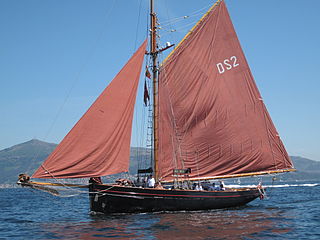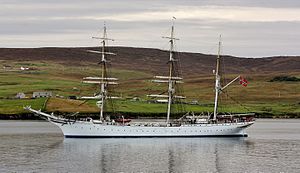
An electric boat is a powered watercraft driven by electric motors, which are powered by either on-board battery packs, solar panels or generators.

A barque, barc, or bark is a type of sailing vessel with three or more masts and mainmasts rigged square and only the mizzen rigged fore and aft. Sometimes, the mizzen is only partly fore-and-aft rigged, bearing a square-rigged sail above.

A tall ship is a large, traditionally-rigged sailing vessel. Popular modern tall ship rigs include topsail schooners, brigantines, brigs and barques. "Tall ship" can also be defined more specifically by an organization, such as for a race or festival.

The Dar Pomorza is a Polish full-rigged sailing ship built in 1909 which is preserved in Gdynia as a museum ship. She has served as a sail training ship in Germany, France, and Poland. Dar Pomorza won the Cutty Sark Trophy in 1980.

Jolie Brise is a gaff-rigged pilot cutter built and launched by the Albert Paumelle Yard in Le Havre in 1913 to a design by Alexandre Pâris. After a short career as a pilot boat, owing to steam replacing sail, she became a fishing boat, a racing yacht and a sail training vessel.

A training ship is a ship used to train students as sailors. The term is mostly used to describe ships employed by navies to train future officers. Essentially there are two types: those used for training at sea and old hulks used to house classrooms. As with receiving ships or accommodation ships, which were often hulked warships in the 19th Century, when used to bear on their books the shore personnel of a naval station, that were generally replaced by shore facilities commissioned as stone frigates, most "Training Ships" of the British Sea Cadet Corps, by example, are shore facilities.

Christian Radich is a Norwegian full-rigged ship, named after a Norwegian shipowner. The vessel was built at Framnæs shipyard in Sandefjord, Norway, and was delivered on 17 June 1937. The owner was The Christian Radich Sail Training Foundation, which was established by a grant from an officer of that name.

The SSV Tole Mour is a 156 ft (48 m) schooner and sail training vessel operating in the Channel Islands of California, off the West Coast of the United States.

Sørlandet is a Norwegian heritage tall ship and one of very few full-rigged ships in the world. She is the senior of the existing Norwegian built square riggers, and for more than 50 years she held a central position in the education and training of young people. She is the second oldest of three Norwegian tall ships, the “Great Trio of Norway”, which besides her includes Statsraad Lehmkuhl and Christian Radich.

Alexander von Humboldt is a German sailing ship originally built in 1906 by the German shipyard AG Weser at Bremen as the lightship Reserve Sonderburg. She was operated throughout the North and Baltic Seas until being retired in 1986. Subsequently, she was converted into a three masted barque by the German shipyard Motorwerke Bremerhaven and was re-launched in 1988 as Alexander von Humboldt. In 2011 the ship was taken off sail-training and sent to the Caribbean for the charter business, then she was converted to a botel.
Operation Sail refers to a series of sailing events held to celebrate special occasions and features sailing vessels from around the world. Each event is coordinated by Operation Sail, Inc., a non-profit organization established in 1961 by U.S. President John F. Kennedy, and must be approved by the United States Congress. Often referred to as OpSail or Op Sail, the event has the goals of promoting good will and cooperation between countries while providing sail training and celebrating maritime history. It is also sometimes erroneously referred to as "Tall Ships". While the tall ships form the centerpiece of the event, smaller sailing vessels also participate.

INS Tarangini is a three-masted barque, commissioned in 1997 as a sail training ship for the Indian Navy. She is square rigged on the fore and main masts and fore-and-aft rigged on the mizzen mast. She was constructed in Goa to a design by the British naval architect Colin Mudie, and launched on 1 December 1995. In 2003–04, she became the first Indian naval ship to circumnavigate the globe.

Picton Castle is a tall ship used for deep-ocean sail training and long distance education voyages. The ship was the subject of the television series Tall Ship Chronicles which documented her second voyage around the world in 2001. The ship has carried out seven world voyages to date - completing the seventh one in 2019. While flagged in the Cook Islands, the ship's unofficial home port is Lunenburg, Nova Scotia.

ARA Libertad (Q-2) is a steel-hulled, full-rigged, class "A" sailing ship that serves as a school vessel in the Argentine Navy. One of the largest and fastest tall ships in the world, holder of several speed records, she was designed and built in the 1950s by the Río Santiago Shipyard, Ensenada, Argentina. Her maiden voyage was in 1961, and she continues to be a training ship with yearly instruction trips for the graduating naval cadets as well as a traveling goodwill ambassador, having covered more than 800,000 nautical miles (1,500,000 km) across all seas, visited about 500 ports in more than 60 countries, and trained more than 11,000 navy graduates.

The Tall Ships Races are races for sail training "tall ships". The races are designed to encourage international friendship and training for young people in the art of sailing. The races are held annually in European waters and consists of two racing legs of several hundred nautical miles, and a "cruise in company" between the legs. Over one half of the crew of each ship participating in the races must consist of young people.

Sea Trek 2001 was a privately organized commemorative sea voyage in 2001, celebrating the 150th anniversary of the migration of members of the Church of Jesus Christ of Latter-day Saints from Europe to the United States during the 19th century. It followed the church's sesquicentennial reenactments of Mormon pioneer wagon trains of 1997.

Duchesse Anne is the last remaining full-rigged ship under French flag. She was built in 1901 with a steel hull by the yard of Joh. C. Tecklenborg of Bremerhaven-Geestemünde (Germany) according to plans drawn by Georg W. Claussen. The mainmast is 48 m tall and 25 sails were rigged. She was used as a training ship for young aspiring sailors in the German merchant marine.

Roald Amundsen, originally named Vilm, is a German steel-ship built on the Elbe River in 1952. Having worked in different areas, she was refitted in 1992 to 1993 as a brig and now serves as a sail training ship. During summer, she usually operates in the Baltic Sea, and usually embarks for journeys to farther destinations for winter, including several trans-Atlantic crossings.
Joh. C. Tecklenborg was a German shipbuilding company, located at the river Geeste in Bremerhaven. About 440 ships of different types, including many famous tall sailing ships were built at the yard. Founded in 1841, it was finally closed in 1928.

















